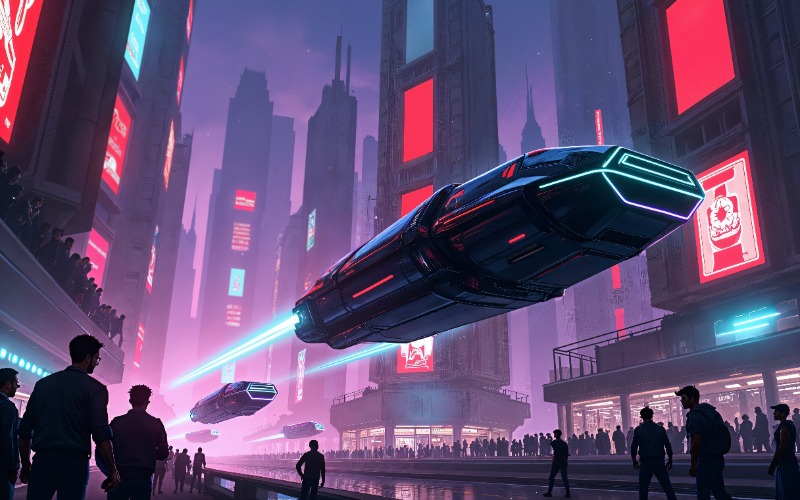I remember watching Back to the Future as a kid and looking forward to the future it predicted. Flying cars! Hoverboards! But here we are, 10 years after the movie’s timeline, and I still need roads wherever I’m going.
It turns out that predicting the future is hard. Really hard. Particularly when trying to do so on an accurate timeline. But that doesn’t mean we can’t spot signals and patterns emerging today that hint at what’s to come. Looking for both of these can help us anticipate future scenarios that we can then choose to prepare for in the work we undertake today.
I think movies can be a valuable resource here. As John Egan, CEO of L’Atelier, once noted, the bigger challenge to prediction isn’t forecasting technological change but understanding societal change. Films can often reflect the cultural pulse of their time while also playing with some of the deeper shifts in how we are living, working, and connecting.
So, as small business owners look to 2025 and beyond, here are a few movies that I think are worth another look as sources of signals and scenarios of the future — both of which can lead us to ask some interesting questions as we make personal or business plans for the year(s) ahead.
Iron Man — Agentic AI
We can’t all be “genius, billionaire, playboy, philanthropist” superheroes, I guess. Nor can we fly around in high-tech metal suits. But the team behind the 2008 Marvel sci-fi movie that introduced J.A.R.V.I.S – Iron Man’s smart and capable AI assistant – were definitely picking up on a signal about the increasing rate of computational power and the evolution of artificial intelligence.
In 2025, we find ourselves on the verge of the next leap forward in this space: agentic AI. AI assistants like Microsoft’s Copilot, Google’s Gemini, and Anthropic’s Claude will be able to take action on behalf of their users. So, rather than just answering questions about our upcoming flight, for example, virtual agents will be able to make changes to our bookings, order inventory for a retail business based on sales projections, or even see what we can see on a screen and move the mouse as we would move it to carry out a process.
What questions does this emerging capability pose to small business owners? Well, how well do you know your processes? How well-documented are they? How digital are they? How would they be able to be scaled or sped up if you had smart agents working alongside you and your human staff? What would you do with the time saved? Could you provide more coverage of customer support queries at odd hours? Is there anything stopping you from rolling out a new product or service that could be resolved with a smart agent?
Ready Player One – Augmented Reality (AR) and Virtual Reality (VR)
The immersive virtual world of Ready Player One might still be a way off (as is the timeline of the sci-fi movie), but the signals pointing to full-sensory VR are emerging, with headsets like Meta’s Quest and the Apple Vision Pro showing increasingly lifelike displays and spatial audio.
More pronounced is the signal about the blending between physical and virtual worlds. When was the last time you checked the price of a product while standing in front of it in a physical store? Or helped your kids pay for a virtual item using real money? The Vision Pro and Quest both allow for a ‘mixed reality’ — where virtual items appear overlaid on the physical world. And if you feel goofy wearing something like that, the Ray-Ban Meta Smart Glasses show how interacting with the physical and virtual world in real time can actually be stylish.
Whether it is called OASIS, the metaverse, or something else, this future is emerging today. As a small business owner, it may be worthwhile asking: What is the next evolution of my website? Does it need to promote more interactivity with my products? Do I have high-enough resolution images and videos of my products to thrive in a high-definition virtual environment? What changes do I need to make to my promotional content, considering it may be viewed by AI rather than humans (like Apple Intelligence reading your marketing emails or an AI assistant answering questions about your product)? Could I train my staff (or customers) more effectively or safely in a virtual reality environment?
Star Trek — Ambient Compute Conversational Interfaces
Pushing the timeline even further out, we really will have to give Star Trek a lot more time – as in a century or two – to see how accurate its predictions about teleportation, replicators, and holodecks really are. But, the imaginations of the creative team behind both the TV series and the many movies were right to pick up on the signals about the access to, miniaturization of, and embedding of computing capability.
Think about those signals and how they are playing out in capabilities that small businesses can already leverage — accessing incredible computing capability from a handheld device is available today. And the signal is only getting stronger as the capability and ubiquity of connectivity continue to develop apace with options like StarLink enabling even remote locations with fast internet access.
Moreover, that interaction is increasingly moving beyond screens. Unlocks in natural language processing and the proliferation of smart speakers, smart watches, smart earphones, and smart homes mean the ability to have a conversation with your computer while your hands are full or while working on a job is definitely within reach.
What, then, are the questions worth asking as these signals of future capability only get stronger? Well, how many of your shop or stockroom processes could be further enhanced by not having to go back to the office laptop or your smartphone to note something, check something, or start something? If someone is asking their smart assistant about a product or service that you offer, what can you do to be in the consideration set? Is there capability out there in the cloud that you aren’t leveraging yet, but which doing so would give your business an advantage in the year ahead?
What Sci-Fi Films Can Teach Us About Technology in Small Business
While we may not have every sci-fi movie vision realized yet, the signals are clear: technology’s transformative power is here and now. Small businesses can use the signals of the future to prompt strategic questions of themselves in the present.
For example, we don’t yet have Tax 3.0 where reporting, payments, and real-time compliance coincide with taxable events. Yet we are seeing faster digital payments and automated e-invoicing. AI isn’t sentient, but it’s automating tasks, providing deep insights, and freeing up time for small business owners.
Just as sci-fi authors and filmmakers imagined futures based on the signals of their time, small businesses today can do the same. By understanding the underlying trends and possibilities, they can harness technology’s power to create their own success stories.











